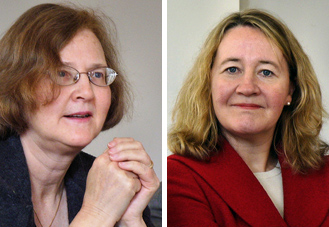Winning work of 2 Nobel Prize recipients has UC Berkeley ties
| 05 October 2009
 Elizabeth Blackburn (left) and Carol Greider (Photo credit: Gerbil, Licensed by Attribution Share Alike 3.0)
Elizabeth Blackburn (left) and Carol Greider (Photo credit: Gerbil, Licensed by Attribution Share Alike 3.0)BERKELEY —The bulk of the work for which Elizabeth Blackburn, Carol Greider and John Szostak won this year's Nobel Prize in Physiology or Medicine took place at the University of California, Berkeley, when Blackburn was a professor of molecular and cell biology and Greider was her graduate student.
The Nobel Prize, announced today (Monday, Oct. 5), was awarded for the trio's discovery of "how chromosomes are protected by telomeres and the enzyme telomerase," according to the Nobel Foundation's press release. This discovery of "a fundamental mechanism in the cell … has stimulated the development of new therapeutic strategies," the foundation added.
Blackburn, 60, left UC Berkeley in 1990 to join the faculty at UC San Francisco. Greider, 48, obtained her Ph.D. from UC Berkeley in 1987 and eventually became a professor at Johns Hopkins University School of Medicine. Her parents both earned UC Berkeley Ph.Ds.
"I'm overjoyed to see my post-doctoral advisor and her advisor be recognized with a Nobel Prize," said Kathleen Collins, a UC Berkeley professor of molecular and cell biology who worked with Greider at the Cold Spring Harbor Laboratory before Greider went to Johns Hopkins, and who continues the chain of telomere research initiated by Blackburn. "And it's also rewarding as a confirmation of the importance of basic research for understanding human health."
| 2009 Chemistry Nobelist also has Berkeley ties |
| Thomas Steitz, who shared the 2009 Nobel Prize in Chemistry, was also a UC Berkeley professor for a brief time in the 1960s. For two years, 1968-1970, he was an assistant professor of biochemistry, though for four of the six quarters he was on leave without pay. He and his wife, Joan Steitz, left UC Berkeley for Yale in 1970. |
Telomeres are repeating segments of DNA that cap the ends of linear chromosomes in all cells. When Blackburn first discovered these tags in the single-celled pond dweller Tetrahymena while a post-doctoral fellow at Yale University, they were a mystery. Continuing her research after joining the UC Berkeley faculty in 1978, Blackburn teamed up with Szostak, a geneticist at Harvard Medical School, to demonstrate that the tags keep chromosomes from being degraded. The researchers also found that cells somehow add these tags onto the ends of their chromosomes.
During the early 1980s, Blackburn and her then-graduate student Greider tracked down the enzyme telomerase that is responsible for continuously replenishing a chromosome's telomeric tips.
"I was on Carol's prelim committee, and I remember when she came in with evidence of the telomerase enzyme, and I remember my jaw dropped," said Michael Botchan, UC Berkeley professor of molecular and cell biology. "It was a wonderful experience, because you don't often get to examine a student on work you know is paradigm shifting."
An explosion of research afterward has shown that, in the absence of telomerase, telomeres shorten each time a cell replicates, and as the DNA tags disappear, the chromosome ends become so short they tend to stick together. This halts further division, and the tissue no longer regenerates. Telomerase adds these tags back, extending the lives of cells.
These discoveries generated hope that boosting telomerase might rebuild chromosome ends and delay aging and, conversely, that blocking telomerase might halt the growth of cancer cells. Both are still subjects of ongoing research.
"It really became clear that this work deserved a Nobel Prize when, through the work of Carol, Liz and their colleagues, it was shown that telomeres and telomerase were involved in cancer and stem cells and even potentially in aging," Borchan said. "But that took several years to emerge."
The initial work by Blackburn, in particular, spawned a whole new field of research.
"Within only 10 years, this went from being a basic question - 'Hey, what do chromosome ends look like?' - to a field of intense research," Collins said. "But it turns out that telomeres and telomerase are more complicated than people thought. Telomeres are not the cause of aging, but they still hold great promise in many areas."
Another of Blackburn's colleagues while she was at UC Berkeley, molecular and cell biology professor Jeremy Thorner, noted that "the important discoveries for which this prize has been awarded - definition of the structure of telomeric DNA and the discovery of the enzyme telomerase that generates the telomeric DNA - were all accomplished, every bit of them, on this campus in the old Stanley Hall. It was the unique mix of an insightful and vivacious mentor energizing her determined and skillful graduate students, with input from a stimulating and creative collaborator, all carried out amidst the intellectual foment that is Berkeley. Clearly, time has shown that was a winning combination!"
Additional information:
-
Video, photos of Elizabeth Blackburn from UC San Francisco
-
The Immortality Enzyme article from ScienceMatters@Berkeley, which describes the work of Kathleen Collins

